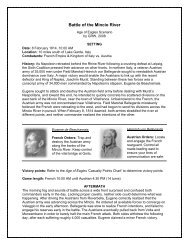Battle of Fere-Champenoise - Free NAPOLEONIC Scenarios
Battle of Fere-Champenoise - Free NAPOLEONIC Scenarios
Battle of Fere-Champenoise - Free NAPOLEONIC Scenarios
Create successful ePaper yourself
Turn your PDF publications into a flip-book with our unique Google optimized e-Paper software.
SCENARIO RULES<br />
1. PACTHOD and PRINCE WILHELM are Charismatic.<br />
2. Historically, a brief, heavy rain around 2:00pm radically impacted the battle. To simulate the<br />
possibility <strong>of</strong> rain, players should roll a D6 at the start <strong>of</strong> every turn. On a roll <strong>of</strong> "1-2," it rains<br />
during that specific turn. Rain halves any movement, removes road movement benefits for the<br />
turn, and halves fire points for shooting.<br />
3. Starting on the 2:30pm turn--and continuing at the start <strong>of</strong> each subsequent turn--the French<br />
player should roll a D6. On a roll <strong>of</strong> "6" PACTHOD and VASSILCHIKOV arrive according to the<br />
deployment rules. It is possible these forces may never arrive, implying Pacthod's destruction.<br />
4. The French deploy first.<br />
6. Lacking an overall commander, the French suffer a -2 penalty for initiative rolls. PRINCE<br />
WILHELM, considered the Allied commander, is +0. Tsar Alexander actually arrived on the field<br />
in the waning stages <strong>of</strong> the battle, around 5:00pm. By then, the French were fleeing the field.<br />
TERRAIN & WEATHER<br />
The gaming table should be six feet long by four feet wide, laid out according to the<br />
accompanying map. Urban areas <strong>of</strong>fer +1 advantages to defending units in melee and a -1<br />
benefit when under fire. Movement along roads <strong>of</strong>fers normal movement benefits, unless rain<br />
occurs (see Scenario Rule #2). The weather is cool and overcast.<br />
DEPLOYMENT<br />
Units set up according to the accompanying map, in any formation they choose. Commanders<br />
must be deployed within 12 inches <strong>of</strong> their commands.<br />
Prince WILHELM begins on the field with his advance guard, as well as PAHLEN'S Russians<br />
and NOSTITZ'S Austrians. Though not technically the overall commander, the prince did act as<br />
the de facto allied commander for the battle. GALLITZIN arrives at 2:00pm (Turn 5) from point<br />
"B".<br />
According to Scenario Rule #3, the retreating French troops north <strong>of</strong> the battle may appear from<br />
in the afternoon. If the appropriate D6 roll is made, PACTHOD appears within 6" <strong>of</strong> point "A"<br />
with infantry in square formation. Units in square may move up to 3" a turn. VASSILCHIKOV<br />
also appears the same turn in hot pursuit, but only two <strong>of</strong> his four units may enter per turn.<br />
SCALE<br />
Each infantry stand represents 360 soldiers, each cavalry stand 180 troopers, and artillery<br />
stands a battery <strong>of</strong> 8-12 guns. Ground scale is one inch to 150 yards.<br />
Notes on Sources<br />
As a small engagement in the waning weeks <strong>of</strong> the Napoleonic Wars, <strong>Fere</strong> <strong>Champenoise</strong> is<br />
difficult to research. The battle is <strong>of</strong>ten mentioned in passing, but rarely in detail. And those<br />
sources which do exist tend to disagree about some important details. Digby Smith, for<br />
instance, says that Marmont's small "corps" had 11,000 men under arms, while Houssaye puts<br />
the number closer to 6,000. This scenario averages the numbers provided by all sources.<br />
Ground scale for the map is verified by Google Maps and Alison's Atlas. For narratives, see<br />
Digby Smith, Charge! (2007), Francis L. Petre's Napoleon at Bay, 1814 (1914) and Henry<br />
Houssaye, Napoleon and the Campaign <strong>of</strong> 1814 (1914), trans. RS McClintock.

















